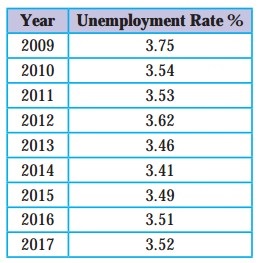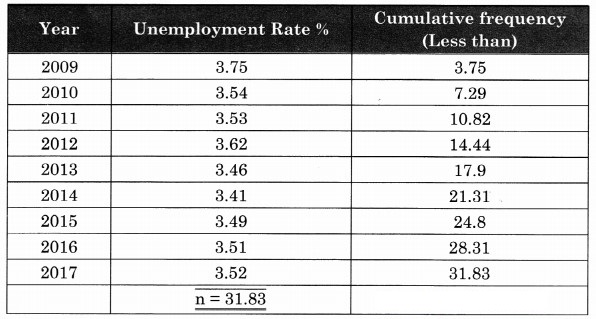Chapter 7 Unemployment in India
1. Find the odd word out:
Question 1.
Urban unemployment – Educated unemployment, Industrial unemployment, Disguised unemployment, Technological unemployment.
Answer:
Disguised unemployment
Question 2.
States with high rates of unemployment – Goa, Punjab, Maharashtra, Tripura.
Answer:
Maharashtra
Question 3.
Employment Guarantee Scheme 1972, Jawahar Rozgar Yojana 1989, Swarnajayanti Gram Swarozgar Yojana 1999, Development of Tourism.
Answer:
Development of tourism
2. Identify and explain the concepts from the given illustrations:
Question 1.
Hussain Shaikh employed seven workers less than the usual number of workers on his farm, in spite of this, output remained the same.
Answer:
Disguised unemployment.
Disguised unemployment is a situation in which more people are doing work than actually required. Thus, even after employing fewer workers than the usual number, the output of Hussain Shaikh remained the same.
Question 2.
The use of new technology in the printing industry has led to unemployment among several workers.
Answer:
Technological unemployment.
Technological unemployment arises due to changes in technology. Modern technology is capital intensive requiring less labour. Thus, the use of new technology displaces few workers from their jobs.
Question 3.
Satish has completed his post-graduation and is desperately expecting a job.
Answer:
Educated unemployment.
Educated unemployment is due to an imbalance between job opportunities and the number of educated youth, preference for white-collar jobs, lack of available skills, etc. Due to the above imbalances, Satish could not get a job easily.
Question 4.
In certain agricultural areas of Maharashtra, only Kharif crops are grown, therefore, employment is available till the month of October.
Answer:
Seasonal unemployment.
Seasonal unemployment is due to slack season or off-season. Kharif crops have a particular season. Thus, for the rest of the period, farmers remain unemployed leading to seasonal unemployment. Such kind of unemployment is also found in the case of tourism, marriage bands, sugar factories, etc.
3. Complete the correlation:
Question 1.
Seasonal unemployment : Tourist guides : : __________ : Graduates
Answer:
Educated unemployment
Question 2.
__________ : Disguised unemployment : : Urban unemployment : Industrial unemployment
Answer:
Rural unemployment
Question 3.
Frictional unemployment : Shortage of raw materials : : __________ : Fluctuations in business activity
Answer:
Cyclical unemployment
Question 4.
MGNREGS : Guaranteed wage employment : : TRYSEM : __________
Answer:
self-employed
Question 5.
__________ : Waste of resources : : Social effect : Loss of human dignity
Answer:
Economic effect
4. Observe the following charts and answer the questions.

Question 1.
Production does not increase if an additional worker is employed and production does not decrease if a worker is reduced from the work. Mention the type of unemployment.
Answer:
Disguised unemployment
Question 2.
A worker is thrown out of a job because of computerization. Name this type of unemployment?
Answer:
Technological unemployment
Question 3.
Sharad was forced to return back to India from the USA due to depression in the IT sector.
Answer:
Cyclical unemployment
Question 4.
In spite of being a graduate, Vasant is sitting idle at home.
Answer:
Educated unemployment
Question 5.
Give examples of structural unemployment.
Answer:
Examples: horse cart replaced by auto-rickshaw; computerized typing replaced manual typists; small traders replaced by malls and online shopping.
5. Find out Q1 and Q3 using unemployment rates as numerical data:

Answer:


6. Answer the following in detail:
Question 1.
Explain the types of Industrial unemployment in India.
Answer:
Types of Industrial unemployment:
(i) Technological unemployment:
Due to the introduction of new machines or new technology, when some workers are removed from their jobs due to lack of proper training. E.g. computerization, the introduction of robotic technology, etc.
(ii) Frictional unemployment:
When due to the breakdown of machines, shortage of raw materials, strikes, power failure, etc. some workers are removed from the jobs, there is said to be frictional unemployment. This is temporary in nature.
(iii) Cyclical unemployment:
During an economic recession, there is a slowdown of economic activities due to a fall in overall demand. Therefore, factory owners remove some workers from their jobs to cut down the cost such unemployment caused due to depression (trade cycle) is called cyclical unemployment.
(iv) Structural unemployment:
It takes place due to structural changes in the economy i.e when due to change in the complete business set up, some workers are removed from their jobs, there is said to be structural unemployment. E.g. introduction of power looms instead of handlooms. It is long-term in nature.
Question 2.
Explain the causes of unemployment in India.
Answer:
Causes of Unemployment:
(i) Jobless growth:
Since independence, the rate of economic growth is less than the growth rate of the population. This leads to widespread unemployment in India.
(ii) Increase in labour force:
Due to the increase in medical facilities since independence, there is a considerable fall in the death rate without a corresponding fall in the birth rate. This led to an increase in the labour force which in turn led to unemployment in India.
(iii) Excessive use of machinery:
Industries as well as agricultural producers are undergoing modernization and have started using more machines and less labour. This means the Indian economy is moving towards capital intensive technique leaving behind labour intensive technique, which led to large scale unemployment.
(iv) Lack of skill development programmes:
Though educational institutions are increasing, no proper training is given to youngsters to work. Development of vocational skill courses is comparatively less in number in India. Hence, there is a lack of skilled manpower required by the industry in India.
(v) Expectations towards employment:
Educated people have high expectations about the salary and they want ‘white-collar jobs’ which are not available in plenty. They prefer to remain unemployed rather than accepting a lower salary. This also causes unemployment.
(vi) Seasonal nature of agriculture:
Due to the seasonal nature of agriculture in India, labourers are employed only for a few months a year and for the rest of the year, they remain jobless. This leads to seasonal unemployment in the country.
(vii) Migration of rural population:
Agriculture being seasonal, there are no alternative jobs available in the off-season or slack season. So the labour migrates to urban areas leading to urban unemployment in the country.
Question 3.
Explain the measures taken by the government to reduce unemployment.
Answer:
The measures taken by the government of India to reduce unemployment are as follows:
General measures to reduce unemployment:
- Development of agricultural sector
- Provision for an alternative occupation
- Development of infrastructure
- Reforms in the educational system
- Development of tourism
- Use of labor-intensive techniques
- Development of information technology and communication
- Provision for vocational training and skill development facilities
- Rural industrialization
- Motivation for self-employment.
Specific measures are undertaken by the government to generate employment opportunities:
Employment Guarantee Scheme (EGS): This Scheme was introduced on 28th March 1972. This scheme was introduced by Maharashtra Government in 1972-73. Under this scheme, work is provided to the registered job-seekers in rural areas within 15 days from the date of registration. This scheme was for unskilled manual labors above 18 years.
Swarnjayanti Gram Swarozgar Yojana (SGSY): This scheme was launched in April 1999 after restructuring the Integrated Rural Developmental Programmer (IRDP) and allied schemes. It’s the only self-employment scheme for the rural poor in India.
Swarna Jayanti Shahari Rozgar Yojana (SJSRY): This scheme was launched in December 1997, It provides gainful employment to the urban unemployed and underemployed. It includes self-employment, women self-employment programme, skill training for employment programme, for this scheme Central Government shares 75% of the cost and State Government shares 25% of the cost.
Pradhan Mantri Rozgar Yojana (PMRY): This scheme is being implemented since 1993 to create and provide sustainable self-employment opportunities to more than one million educated unemployed youth.
Training Rural Youth for Self-employment (TRYSEM): It was initiated in 1979 with the objective of tackling the unemployment problem among rural youth. It aimed at training about 2 lakh rural youth every year to enable them to become self-employed.
Besides the above measures, there are many other specific measures undertaken by the government. They can be named as:
- Jawahar Rozgar Yojana (JRY)
- Mahatma Gandhi National Rural Employment Guarantee Scheme (MGNREGS)
- Deen Dayal Upadhyaya Grameen Kaushalya Yojana 2014
- National Policy for Skill Development and Entrepreneurship – 2015
- Startup India Initiative
- Pradhan Mantri Kaushal Vikas Yojana – (2016-20)
Intext Questions and Answers
Do you know? (Textbook Page No. 46)
State-wise unemployment rates in India (2015-16)

Answer:
Ranks | State | No. of people | Cumulative Frequency (Less than) |
1. | Tripura | 197 | 197 |
2. | Sikkim | 181 | 378 |
3. | Kerala | 125 | 503 |
4. | Himachal Pradesh | 106 | 609 |
5. | Assam | 96 | 705 |
6. | Arunachal Pradesh | 89 | 794 |
7. | Nagaland | 85 | 879 |
8. | Jharkhand | 77 | 956 |
9. | Uttar Pradesh | 74 | 1030 |
10. | Jammu and Kashmir | 72 | 1102 |
11. | Rajasthan | 71 | 1173 |
12 | Uttarakhand | 70 | 1243 |
13. | Goa | 61 | 1304 |
14. | Punjab | 60 | 1364 |
15. | Bihar | 60 | 1424 |
16. | Manipur | 57 | 1481 |
17. | Odisha | 50 | 1531 |
18. | West Bengal | 49 | 1580 |
19. | Meghalaya | 48 | 1628 |
20. | Haryana | 47 | 1675 |
21. | Madhya Pradesh | 43 | 1718 |
22. | Tamilnadu | 42 | 1760 |
23. | Andhra Pradesh | 39 | 1799 |
24. | Mizoram | 30 | 1829 |
25. | Telangana | 28 | 1857 |
26. | Maharashtra | 21 | 1878 |
27. | Chhattisgarh | 19 | 1897 |
28. | Karnataka | 15 | 1912 |
29. | Gujarat | 09 | 1921 |
n = 1921 |
